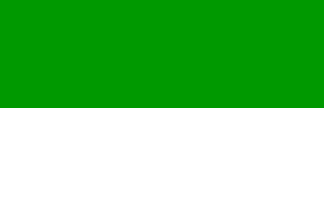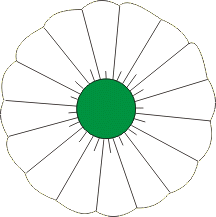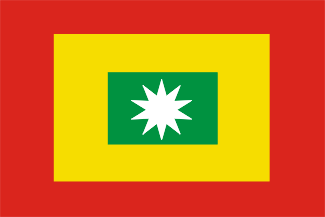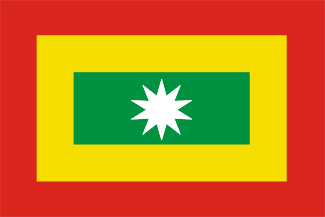 klaus-michael schneider
klaus-michael schneider
Keywords: bolivar | colombia | cartagena | nueva granada | barranquilla |
Links: FOTW homepage | search | disclaimer and copyright | write us | mirrors

Last modified: 2021-08-26 by  klaus-michael schneider
klaus-michael schneider
Keywords: bolivar | colombia | cartagena | nueva granada | barranquilla |
Links: FOTW homepage |
search |
disclaimer and copyright |
write us |
mirrors
See also:

image
by António Martins-Tuválkin, 10 April 2016

image
by António Martins-Tuválkin, 10 April 2016

image
by Jaume Olle, 15 September 2001

image
by Jaume Olle, 15 September 2001
All sources confirms that Cartagene used the colours green and
white, but it is not known in which order. I will follow Restrepo
Uribe who said that was green over white, but I have at
least two quotations speaking about white and green colours. Most
probably is that both forms were used. About in 1810 those
colours were mainly used as cockarde, but also as banners, flags
and bands. Of course proportions 2:3 (as I reconstructed the
images) are unrealistic. Each flag used must be of different
size, hand made. Same is for shade of green that must be from the
fabric available. This colours were used only after 11 November
1811 and until at less January 1812.
Jaume Olle, 15 September 2001
Both flag images redrawn from Jaume's originals, with optimized palettes,
symmetry, no border, and standard color shades.
António Martins-Tuválkin, 10 April 2016

by Jaume Olle, 15 September 2001

by Jaume Olle, 15 September 2001
On January 1812 Cartagena flag was adopted. Official
Description is available, but accurate reconstruction is
difficult. Following authors the flag can be reconstructed in
differents ways. The flag deawn by Ricaurte and followed by
Restrepo is the above. I believe that we should accept this
reconstruction, but others were not discarded yet. Number of the
Star's points and its exact form must be variable. Since the star
is quoted as argent, some authors draw it as grey, but in the
flags it should be white. If it was grey (or better argent), it
was because that in 1812 those flags were manufactured with
embrodoined decorations. The same flag later adopted
provisionally by the Federal government of the United provinces
(26 April 1814) and was reconstructed some years ago for to be
adopted by Atlantic department before 1989. [See: Barranquilla]
According the Colombia constitution appendix the central star is
white (but five pointed) but was manufactured and used with
eighpointed star (white, but also yellow). Reconstruction with
eighpointed star was made with intervention of some historians
and must be accurate.
Why the 8 points stars? - Provinces of the spanish viceroyalty of
the Kingdom of New Granada, were not eight in number. Excluding
Venezuela general capitancy (which was ruled separately), the
viceroyalty has two sections: the Audience of Santa Fe and the
Presidency of Quito. Considering only Audiency of Santa Fe, then
exists: Antioquia, Cartagena, Casanare, Citara, Mariquita, Neiva,
Pamplona, Panama, Popayan, Riohacha, Santa Fe, Santa Marta,
Socorro, Tunja and Veragua. Rio Hacha, Popayan,Santa Marta,
Panama and Veragua remained in hands of Spain, and in hands of
independentist were 10 provinces, however not all at same time -
they separated from Spain between 1810 and 1813. 15 other juntas
were formed in several parts and some regions as separated
entities (Nuevita, Mompox, Giron, Timana de Garzon, Cali...).
The Federal pact was signed 8 November 1811 by only five
provinces (Antioquia, Cartagena, Pamplona, Neiva and Tunja) but
later others adhered to the federal pact. Cundinamarca adhered,
left, and afterwards was conquered by federals (led by Simon
Bolivar). Socorro was recognized as part of Cundinamarca.
Mariquita joined Cundinamarca (as other minor governments).
Nuevita and Citara merged de facto (Choco). Concering other
provinces, it is not clear if those were adhered to the federal
pact. Cartagena considered Santa Marta under its jurisdiction and
Mompox was conquered. Cauca Valley was established and the
provicial capital, Popayan, was conquered several times, but
reconquered by spanish from Pasto. At least 14 sovereign
constitutions (one or more for each) are known or quoted by
historist. We can suspect than, when Cartagena flag was adopted
in january 1812, eight provinces joined already the federation,
and Cartagena was then the leading one. I believe that the 8
states must have been the five founders and Cauca Valley
confederated cities, Citara and Nuevita. Federal congress
was moved to Tunja and in 1812 a pact established the
incorporation of Cundinamarca but didn't entered into full
effect. Information lack concering the flags of Antioquia,
Mompox, Neiva, Timana de Garzon, Pamplona, Casanare, Citara and
Novita (I believe that no other states could have flags of its
own and some of them probably didn't have one). Recents
informations discovered that Antioquia adopted arms in 1812
(published in Flag Report), but not mention of flag in the
documents found in the archives.
Jaume Olle, 15 September 2001
While reading Herbert Asbury's "The Gangs of New
Orleans" a reissue of his 1936 "The French Quarter: An
Informal History of the New Orleans Underworld" (Renamed to
latch on to the same author's "Gangs of New York) I came
across the following passage: "After piracy in the grand
manner came to an end...the commerce of the Gulf continued to be
plundered, under the flimsy guise of legality, by the
privateers.... Within a few years after the turn of the
nineteenth century the Gulf of Mexico fairly swarmed with
piratical craft, most of which operated safely within the
international law by flying the flag of the Republic of
Cartagena"
prometevsberg, 13 March 2004